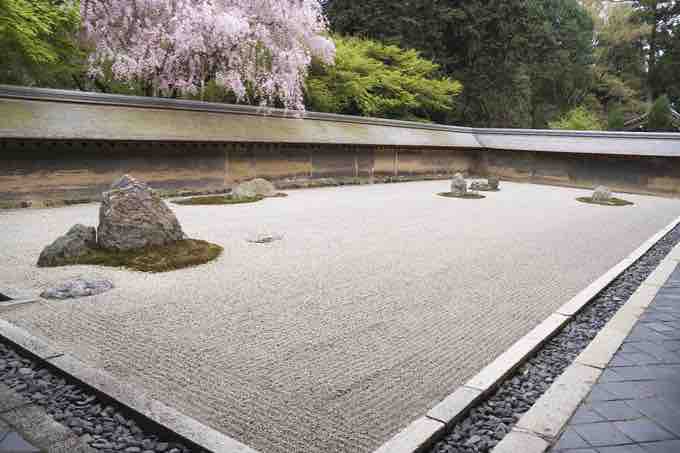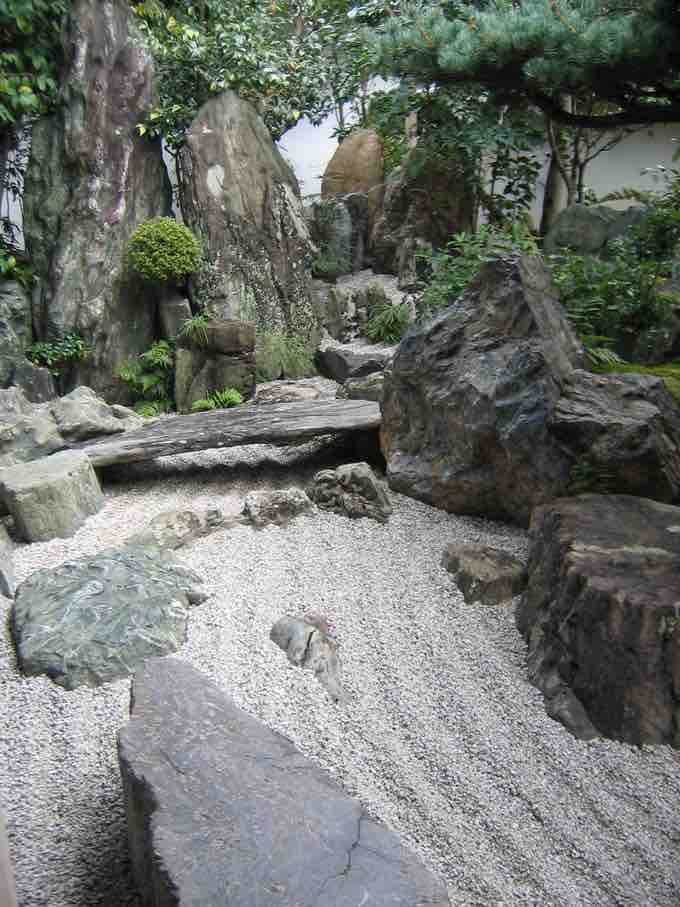Background: The Muromachi Period
The Muromachi Period in Japan, which took place at roughly the same time as the Renaissance in Europe, was characterized by political rivalries that frequently led to wars. However, it was also characterized by an extraordinary flourishing of Japanese culture. It saw the beginning of Noh theater, the Japanese tea ceremony, the shoin style of Japanese architecture, and the zen garden.
A New Kind of Garden
Zen Buddhism was introduced into Japan at the end of the 12th century. It quickly achieved a wide following, particularly among the Samurai class and war lords, who admired its doctrine of self-discipline. The gardens of the early zen temples in Japan resembled Chinese gardens at the time, with lakes and islands. However, in Kyoto in the 14th and 15th century, a new kind of garden appeared at the important zen temples. These zen gardens were designed to stimulate meditation. "Nature, if you made it expressive by reducing it to its abstract forms, could transmit the most profound thoughts by its simple presence," Michel Baridon, a well-know researcher, wrote. "The compositions of stone, already common China, became in Japan, veritable petrified landscapes, which seemed suspended in time, as in a certain moments of Noh theater, which dates to the same period."
Saihō-ji
The first garden to begin the transition to this new style is considered by many experts to be Saihō-ji, The Temple of the Perfumes of the West—popularly known as Koke-dera, the Moss Garden—in the western part of Kyoto. The Buddhist monk and zen master Musō Kokushi transformed a Buddhist temple into a zen monastery in 1334 and built the gardens. The lower garden of Saihō-ji is in the traditional Heian Period style: a pond with several rock compositions representing islands. The upper garden is a dry rock garden featuring three rock "islands." The first, called Kameshima (the island of the turtle), resembles a turtle swimming in a "lake" of moss. The second, Zazen-seki, is a flat meditation rock that is believed to radiate calm and silence. The third island is the kare-taki, a dry "waterfall" composed of a stairway of flat granite rocks. The moss that now surrounds the rocks and represents water was not part of the original garden plan; it grew several centuries later when the garden was left untended. However, is now the most famous feature of the garden.
The moss gardens of Saihō-ji
Golden Pond, in the center of the moss garden.
Tenryū-ji
Muso Kokushi built another temple garden at Tenryū-ji, known as the Temple of the Celestial Dragon. This garden appears to have been strongly influenced by Chinese landscape paintings of the Song Dynasty, which feature mountains rising in the mist and suggest great depth and height. The garden at Tenryū-ji has a real pond with water and a dry waterfall of rocks, appearing similar to a Chinese landscape. Saihō-ji and Tenryū-ji show the transition from the Heian style garden toward a more abstract and stylized view of nature.
Ginkaku-ji
The gardens of Ginkaku-ji, also known as the Silver Pavilion, are also attributed to Muso Kokushi. This temple garden includes a traditional pond garden, but it had a new feature for a Japanese garden: an area of raked white gravel with a perfectly shaped mountain of white gravel, resembling Mount Fuji, in the center. The scene is called ginshanada, or "sand of silver and open sea." This garden feature became known as kogetsudai, or "small mountain facing the moon." After this garden was built, similar small Mount Fujis made of sand or earth covered with grass appeared in Japanese gardens for centuries afterwards.
1024px-Ginkakuji_Temple_mars_2009_053.jpg
The gardens at Ginkaku-ji, commonly known as the Silver Pavilion. The viewer can see the perfectly shaped mountain of white gravel, resembling Mount Fuji, in the center.
Ryōan-ji
The most famous of all zen gardens in Kyoto is Ryōan-ji, built in the late 15th century where, for the first time, the zen garden became purely abstract. The garden is a rectangle of 340 square meters. Placed within it are 15 stones of different sizes, carefully composed in five groups: one group of five stones, two groups of three, and two groups of two stones. The stones are surrounded by white gravel, which is carefully raked every day by the monks. The only vegetation in the garden is some moss around the stones. The garden is meant to be viewed from a seated position on the veranda of the hōjō, the residence of the abbot of the monastery.

Ryōan-ji (late 15th century) in Kyoto, Japan, a famous example of a zen garden
The most famous of all zen gardens in Kyoto is Ryōan-ji, built in the late 15th century where for the first time the zen garden became purely abstract
Daisen-in
The garden at Daisen-in (1509-1513) took a more literary approach than Ryōan-ji. A "river" of white gravel represents a metaphorical journey through life—beginning with a dry waterfall in the mountains, passing through rapids and rocks, and ending in a tranquil sea of white gravel with two gravel mountains.

A mountain, waterfall, and gravel "river" at Daisen-in (1509–1513)
The garden at Daisen-in (1509-1513) took a more literary approach than Ryōan-ji, with its "river" of white gravel representing a metaphorical journey through life.